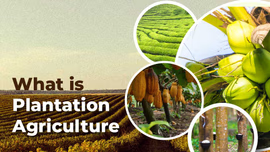How to Grow Coriander: Best Practices for Profitable Farming in India

Table of Content
- Introduction
- What are the Good Agricultural Practices for Growing Coriander?
- What are the Coriander Varieties Cultivated in India?
- Which are the Top 5 Coriander Producing States in India?
Introduction
Coriander is an important seed spice derived from coriander plant, which is a thin stemmed, small bushy herb with a stronger and earthy aroma. It belongs to family Apiaceae. It grows up to 25 – 80 cm in height and has many branches and umbels. Its fruits are globular and 3 – 4 mm in diameter.
Coriander plant is a native to Mediterranean region, especially region between South West Asia to North Africa. It is known by different names across the world, such as Dhaniya & Kothambari in India, and Cilantro in the USA.
Coriander is commercially cultivated across Rajasthan, Madhya Pradesh, Andhra Pradesh, Tamil Nadu, Odisha, Uttar Pradesh and Uttarakhand states of India. Among all the states, Madhya Pradesh occupies the top position in total area under cultivation and production.
Young coriander plant is largely used for making chutney and garnishing dishes in India. Its dried brown seeds are used as condiments in form of powder, sausages and seasoning.
What are the Good Agricultural Practices for Growing Coriander?
Soil & Climate for Cultivating Coriander
Coriander is a tropical crop cultivated mainly in Rabi Season, but can be grown throughout the year for leaf purposes. For the purposes of seed, a dry and cold weather free from frost during flowering and fruit-setting is required. The ideal climate and soil requirements are as under:
|
Agro-climatic variables |
Conditions |
|
Climate |
Dry, cool and frost-free weather |
|
Temperature |
20 – 25°C |
|
Soil |
- Well drained loamy or silt soil for irrigated lands. - Clayey soil in unirrigated lands. - pH value should be in 6 – 8 range. |
|
Season |
June – July and October – November |
However, it should not be grown under following conditions:
- Extremely hot weather: During March – May period as it can affect the germination of coriander.
- Heavy rainfall and cloudy weather: It can invite diseases and aphids.
- Saline alkaline and sandy soils
Preparing the Field for Sowing Coriander Seed
Coriander is cultivated as irrigated and rainfed crop. Before sowing the seed, the field should be ploughed with the help of a Cultivator or a MB Plough to bring the soil to fine tilth. Immediately after ploughing, do not forget to do planking to prevent loss of soil moisture.
Additionally, treat the soil with 1.5% Quinolphos or 2% Methyl Parathion dust at the rate of 20 – 25 kg/ hectare. This will help control termite and white aunt.
Sowing of Coriander Seed
- Sowing method: In India both the line sowing and broadcasting method is followed. However, line sowing is advisable as it allows easy inter-cultural operations. Thus, the recommended line spacing and plant spacing for maximum yield is 25 – 30 cm and 10 – 15 cm, respectively.
- Sowing time: It is dependent upon the day time temperature. Sow the coriander seeds when the temperature is below 25° C. If you are growing coriander for leaf purposes then you can do it throughout the year except spring season, when the temperature is too high.
- Seed rate: It should be in the 10 -12 kg/hectare range for irrigated corianders and in the 15 – 20 kg/ hectare range for rainfed corianders. However, seed rate is influenced also by the seed size, varieties and growth habit.
- Seed treatment & inoculation: Treat the coriander seeds with Captan or Bavisting or Thirum @ 2 gram per kg seed, or with Trichoderma @ 4 – 6 gram per kg seed. Also, inoculate the seed with Phosphate Solublising Bacteria and Azotobactor. These will help protect the coriander crop from seed borne diseases.
Fertilizers & Manures Application in Coriander Farms
Fertilizers and manures shall be mixed with top soil 3 weeks before sowing in following manner:
- Farmyard Manure (FYM): 10 – 15 tonnes per hectare
- Nitrogen (N): 60 kg
- Phosphorus Pentaoxide (P2O5): 60 kg
- Potassium Oxide (K2O): 20 kg
Now, out of this one-third of N and full dose of P2O5 and K2O should be applied as basal dose and the remaining two-third of N should be applied at an interval of 30 and 60 days after sowing.
Irrigation of Coriander
Irrigation of coriander farms is critical at seeding stage (30 – 40 days after sowing), grand growth period (50 – 60 days after sowing) and seed formation stage (90 – 100 days after sowing).
Further, the irrigation of coriander varies as per the soil and weather.
- Black soil: 2 – 3 irrigations
- Light textured soil: 4 – 5 irrigations
Drip Irrigation or Sprinkler Irrigation may also be given for saving of water and nutrients.
Weed Management in Coriander Farms
Weeding and hoeing of coriander farms is critical to keep the coriander crops free from weed. It is required two times, 30 – 40 days after sowing, and second, 60 – 65 days after sowing. Usually, rainfed coriander does not require weed management. It is required 2 – 3 times in irrigated coriander.
Plant Protection Measures
Plant protection measures are need to protect the coriander plants from insect pests, such as Aphids, and diseases, such as Wilt and Blight.
Aphids
It sucks the plant sap from tender flowers and parts causing the coriander plant to turn yellow. It results in poor seed formation.
To deal with it spraying 500 – 700 litre emulsion of 0.005% Imidaclorphid, or 0.03% dimethoate has been found to be the most effective. Do not forget to spray the pesticide for second time after a gap of 10 – 15 days.
Wilt
Wilt affects the plant after one month of sowing. It dries up the coriander crop. To treat it, coriander seed with Bavistin @ 2 – 2.5 grams per kg seed, or with Trichoderma @ 6 gram per kg seed is required.
Blight
The dark brown spot on the stem and the leaves is called blight. Spraying 500-700 litre per hectare solution of 0.1% Propiconazole or 0.2% DithaneM-45 before commencement is required to control the disease. Repeat the process of spraying at an interval of 15 days.
Frost control
In unirrigated condition the chance of frost attack is more in coriander in North India. Burning of waste material on the bunds of fields during night is useful protecting the crop against frost.
if irrigation facility is available, then irrigation the crop. When the chance of frost is more than spray 0.1% Sulphuric acid at flowering stage, protect the crop from frost.
Harvesting and Yield
Coriander should be harvested when 50% of the green seeds turn yellow. To obtain extra yield, leaf plucking to the extent of 50% at 75 days after sowing without reduction in seed yield may be done.
Usually, a sickle is used to harvest coriander crop. Once the coriander is harvested dry it in shade to prevent the loss of volatile oil. Post-this, separate the grain by beating and dry and clean it before sowing.
The use of high yielding seed varieties and good agricultural practices can give an average yield of 10 – 15 quintals per hectare (irrigated coriander) and 4 –5 quintals per hectare (rainfed coriander).
What are the Coriander Varieties Cultivated in India?
|
State |
Varieties Cultivated |
|
Andhra Pradesh |
Swathi, Sindhu, Lam SelectionCS2, Sadhana |
|
Bihar |
Rajendra Swathi and Rajendra Sonia |
|
Haryana |
Hisar Sugandh, Hisar Anand and Hisar Surabhi |
|
Gujarat |
GCr-1 and GCr-2 |
|
Rajasthan |
ACr-1, RCr- 41, RCr-20, RCr -435, RCr-436, RCr -684, RCr -446 |
|
Tamil Nadu |
Co-1, Co-2, Co-3 and CS-287 |
Which are the Top 5 Coriander Producing States in India?
According to the Agricultural Statistics Book 2023, the total production of coriander in 2022-23 was 948 thousand metric tonnes and the area under coriander cultivation stood at 711 thousand hectares. Among the top coriander producing states, Madhya Pradesh occupies the top position. The top 5 state-wise production of coriander in the year 2021-22 are given as under:
|
State |
Area (in thousand ha.) |
Production (in MT) |
|
Madhya Pradesh |
299 |
401 |
|
Gujarat |
141 |
218 |
|
Rajasthan |
124 |
182 |
|
Assam |
31 |
36 |
|
Odisha |
20 |
11 |
Frequently Asked Questions On How to Grow Coriander: Best Practices for Profitable Farming in India
1. Which is the largest coriander producing state in India?
Madhya Pradesh is the largest coriander producing states in India.
2. Which is the best season to grow coriander in India?
June – July and October – November are the best season to grow coriander in India.
3. Is coriander farming profitable?
The high demand for coriander makes it a profitable farming in India.
4. In how many does the coriander is ready to be harvested?
Coriander is best for harvesting after 75 days of sowing.


Related Blogs












